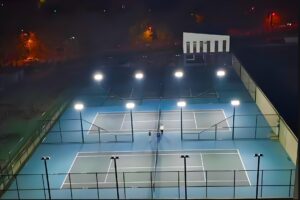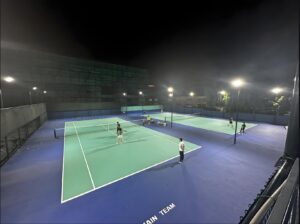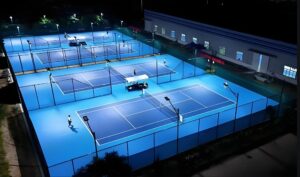LED lights provide a highly cost-effective solution for high-use environments like sports venues, where lighting needs to be reliable, long-lasting, and energy-efficient. Their extended lifespan, coupled with reduced energy consumption, minimal maintenance needs, and consistent light output, ensures significant savings in operational costs over time. The reduced frequency of replacements and maintenance, combined with their energy efficiency, makes LEDs a valuable investment for venues that require high-intensity lighting for extended periods, such as tennis courts, stadiums, and arenas. The cost-effectiveness of LED lighting, combined with its sustainability benefits, ensures that it will remain the lighting choice for high-use environments in the years to come.
Resistance to environmental factors like vibrations and humidity
One of the key advantages of LED lighting, particularly in high-use environments like sports venues, is its resistance to environmental factors such as vibrations and humidity. These factors can significantly impact the longevity and performance of traditional lighting systems. LED lights, however, are designed to withstand these challenges, making them particularly suitable for environments where the lighting system is exposed to frequent physical movement, temperature fluctuations, or high levels of moisture. Below, we explore how LED lights perform in such conditions and why they are a better choice for environments subject to vibrations and humidity.
1. Vibration Resistance
- Solid-State Construction: Unlike traditional lighting systems such as incandescent, halogen, or metal halide lamps, which contain fragile filaments or glass components, LEDs are solid-state lights. This means that they have no moving parts or glass filaments that can be easily damaged by vibrations. The absence of these fragile elements makes LEDs inherently more durable and resistant to physical shocks and vibrations.
- Ideal for High-Vibration Environments: Sports venues, especially those with large outdoor arenas or stadiums, often experience vibrations due to foot traffic, machinery, or equipment. In environments such as tennis courts or arenas where lighting systems may be exposed to constant motion (e.g., during set-up, post-match dismantling, or nearby construction), LED lights are better equipped to handle such physical stresses without degradation. This makes LEDs particularly suitable for stadiums or venues with high foot traffic and other vibration-inducing activities.
- Longer Lifespan in High-Vibration Settings: Traditional lighting systems often fail prematurely in high-vibration environments, as vibrations can damage delicate filaments or cause components to loosen or crack. LED lights, by contrast, continue to perform reliably even in these conditions, ensuring longer-lasting performance and reducing the frequency of maintenance or replacements.
 2. Humidity and Moisture Resistance
2. Humidity and Moisture Resistance
- Sealed and Weatherproof Design: LED lighting fixtures are typically designed with weather-resistant, sealed enclosures to protect their internal components from external elements such as moisture, dust, and dirt. Many LEDs come with an IP (Ingress Protection) rating that indicates their resistance to dust and water. Common ratings for outdoor and high-moisture environments include IP65 (dust-tight and protected against water jets) and IP67 (protected against immersion in water up to 1 meter).
- Suitability for Outdoor and Indoor Venues: Whether in outdoor tennis courts, sports arenas, or indoor pools, where high humidity and potential water exposure are common, LEDs perform well under such conditions. Their sealed design prevents water and humidity from damaging their internal components, unlike traditional lighting systems, which may corrode, rust, or short-circuit when exposed to moisture over time. This resistance to environmental factors ensures that the LED lights continue to operate effectively even in humid or wet conditions.
- Corrosion-Resistant Materials: Many high-quality LED fixtures are constructed using corrosion-resistant materials like aluminum or stainless steel. This further enhances their durability in environments exposed to humidity, rain, or salty air, such as coastal areas or covered outdoor sports venues. Unlike traditional lights, which may suffer from rust or corrosion, LEDs retain their integrity and performance, extending their lifespan and minimizing maintenance needs.
3. Performance in Temperature Extremes
- Wide Operating Temperature Range: LEDs can operate effectively across a wide range of temperatures, from as low as -40°C (-40°F) to as high as 60°C (140°F), depending on the specific design and the environment. This is particularly advantageous in sports venues where temperature extremes can occur, especially for outdoor events or in regions with fluctuating climates. Traditional lighting systems, such as metal halide or sodium vapor lights, may experience performance degradation or failure if exposed to extreme temperatures.
- Heat Resistance and Low Heat Emission: LEDs generate significantly less heat than traditional lighting sources. This is not only energy-efficient but also reduces the likelihood of overheating in humid or high-temperature environments. High levels of heat can cause traditional lights to fail more quickly, particularly in environments where humidity and moisture levels are also high. With LEDs, the low heat emission helps mitigate this risk, contributing to their overall durability and longevity.
4. Impact on Operational Downtime and Maintenance
- Reduced Risk of Failure: Because of their robustness against vibrations and moisture, LEDs experience fewer failures in the field, reducing the likelihood of operational downtime. For sports venues, this is a critical factor, as lighting failures during live events or tournaments can disrupt matches and affect the viewer experience. The reliability of LEDs in challenging environmental conditions ensures that the lighting system operates smoothly with minimal interruptions.
- Less Frequent Maintenance and Repairs: The durability of LEDs in high-vibration and high-humidity environments means fewer breakdowns and less frequent repairs. Traditional lighting systems often require regular servicing, particularly in environments subject to moisture and physical movement. This increases maintenance costs, labor, and the risk of downtime. LEDs, with their weatherproof and shock-resistant design, require significantly less maintenance, which leads to cost savings in the long run.

5. Environmental Impact and Sustainability
- Long-Term Environmental Benefits: LEDs’ ability to withstand environmental challenges such as humidity and vibration not only reduces the need for frequent replacements but also supports sustainability efforts. By maintaining consistent performance over time, LEDs contribute to lower resource consumption and waste. Their longer lifespan means fewer lights end up in landfills, and their energy efficiency reduces the environmental impact of energy production, particularly in large-scale sports venues.
- Lower Carbon Footprint: The durability of LEDs under harsh environmental conditions supports efforts to reduce a venue’s overall carbon footprint. By reducing the frequency of lighting system replacements and decreasing maintenance-related emissions, LED lighting systems can contribute to a venue’s environmental sustainability goals.
LED lights’ resistance to environmental factors such as vibrations and humidity makes them a highly reliable and durable choice for high-use environments like sports venues, particularly tennis courts and stadiums. Their solid-state construction, weatherproof design, and ability to withstand extreme temperatures and physical stresses ensure that they perform optimally in challenging conditions where traditional lighting systems may fail. LEDs offer a significant advantage in terms of reduced maintenance, fewer failures, and a longer lifespan, which ultimately leads to cost savings and greater operational efficiency. With their ability to handle harsh environments while delivering consistent and high-quality light, LEDs are undoubtedly the ideal lighting solution for demanding, high-performance venues.
Uniform Light Distribution
Importance of consistent brightness and even coverage in tennis
In tennis, where precision, timing, and focus are crucial to a player’s performance, the quality of the lighting can have a profound impact on the outcome of a match. Consistent brightness and even coverage are not just important for ensuring fair play, but also for maintaining a high-quality viewing experience for both players and spectators. Lighting plays an essential role in providing optimal conditions for players to perform at their best and for ensuring that television broadcasts are clear and visually appealing. Below, we explore why consistent brightness and even coverage are especially important in tennis and how LED lighting systems help achieve these conditions.
1. Impact on Player Performance
- Clear Visibility of the Ball: Tennis is a fast-paced sport where players need to track the ball with great precision. Inconsistent lighting or shadowy areas on the court can make it difficult for players to track the ball effectively, leading to mistakes or impaired reactions. A well-lit court with even coverage ensures that the ball is visible at all times, regardless of its position or speed. Bright, consistent lighting helps players see the ball clearly, both in the air and when it bounces, enabling better judgment and performance.
- Reducing Eye Strain: Players spend long hours on the court, and prolonged exposure to uneven or flickering lighting can cause eye strain and fatigue. This not only affects their concentration but also their physical performance. Even and stable lighting ensures that players can maintain focus and energy throughout the match without the added distraction of adjusting to lighting inconsistencies. A uniform level of brightness across the court helps reduce discomfort, allowing players to concentrate fully on the game.

2. Ensuring Fair Play
- Avoiding Favorable Lighting Conditions for One Player: In outdoor tennis matches, especially those held during the evening or in indoor venues, inconsistent lighting can create areas of the court that are either too bright or too dim. This can unfairly favor one player over another, depending on their position relative to the lights. For example, if one side of the court is brightly lit while the other is in shadow, the player on the bright side will have a distinct advantage. Consistent brightness across the entire playing surface ensures that all players are subjected to the same lighting conditions, promoting fairness and equity during the game.
- Eliminating Shadows: Shadows can be particularly distracting in tennis, especially when they fall across the court or the player’s path. A lack of even coverage can result in shadows caused by fixtures, poles, or uneven light distribution. These shadows can cause the ball to blend into dark spots, making it harder for players to track it. Consistent and even lighting eliminates these shadows, ensuring that players have clear sightlines at all times.
3. Improved Broadcast Quality
- Uniform Lighting for TV Broadcasts: High-quality television broadcasts of tennis events rely on consistent and even lighting to ensure that the camera captures every moment clearly. Inconsistent lighting can cause parts of the court to appear too dark or too bright, leading to poor image quality, harsh shadows, or overexposure in certain areas. This can be frustrating for viewers, as it disrupts their ability to follow the action.
- Enhanced Visual Appeal for Viewers: For television or streaming broadcasts, evenly distributed lighting enhances the viewer’s experience by providing a clear, crisp image of the court, the players, and the ball. Even lighting also improves color rendering, ensuring that the audience can appreciate the full spectrum of the court’s colors and the players’ uniforms. Consistent brightness eliminates flickering and reduces potential visual distractions, helping maintain a smooth and engaging viewing experience.
- Accurate Camera Tracking: Professional tennis broadcasts use a variety of cameras to capture the action from different angles. To ensure smooth transitions between shots and an accurate portrayal of the game, the lighting must be uniform to avoid exposure issues when switching between cameras. LEDs, with their ability to provide flicker-free light, are ideal for sports broadcasting, as they maintain steady light levels without causing image distortion or video glitches.
4. Player Safety
- Reduced Risk of Injury: Inconsistent lighting can increase the likelihood of accidents or injuries during a match. If certain areas of the court are darker or harder to see, players may misjudge the trajectory of the ball or the speed of their movements, leading to poor decisions or even collisions with the net or boundary lines. A well-lit, evenly illuminated court provides players with the necessary visual cues to anticipate movements and react quickly, thereby reducing the risk of injury.
- Improved Reaction Times: Tennis players are known for their quick reflexes and agility. If lighting is inconsistent, players may have delayed reactions due to difficulty seeing the ball clearly, leading to potential injuries. Consistent and even coverage ensures that players can anticipate and react to the ball’s movement with speed and precision, enhancing both safety and performance.
(To Be Continued)
 2. Humidity and Moisture Resistance
2. Humidity and Moisture Resistance
